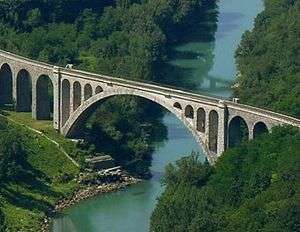Bohinj Railway
The Bohinj Railway (Slovene: Bohinjska proga, Italian: Transalpina, German: Wocheiner Bahn) is a railway in Slovenia and Italy. It connects Jesenice in Slovenia with Trieste in Italy. It was built by Austria-Hungary from 1900 to 1906 as a part of a new strategic railway, the Neue Alpenbahnen, that would connect Western Austria and Southern Germany with the then Austro-Hungarian port of Trieste. The line starts in Jesenice, at the Southern end of the Karawanks Tunnel; it then crosses the Julian Alps through the Bohinj Tunnel, and passes the border town of Nova Gorica before crossing the Italian border and reaching Trieste.
| Jesenice–Nova Gorica–Trieste Campo Marzio Bohinj Railway | ||||||||||||||||||||||||||||||||||||||||||||||||||||||||||||||||||||||||||||||||||||||||||||||||||||||||||||||||||||||||||||||||||||||||||||||||||||||||||||||||||||||||||||||||||||||||||||||||||||||||||||||||||||||||||||||||||||||||||||||||||||||||||||||||||||||||||||||||||||||||||||||||||
|---|---|---|---|---|---|---|---|---|---|---|---|---|---|---|---|---|---|---|---|---|---|---|---|---|---|---|---|---|---|---|---|---|---|---|---|---|---|---|---|---|---|---|---|---|---|---|---|---|---|---|---|---|---|---|---|---|---|---|---|---|---|---|---|---|---|---|---|---|---|---|---|---|---|---|---|---|---|---|---|---|---|---|---|---|---|---|---|---|---|---|---|---|---|---|---|---|---|---|---|---|---|---|---|---|---|---|---|---|---|---|---|---|---|---|---|---|---|---|---|---|---|---|---|---|---|---|---|---|---|---|---|---|---|---|---|---|---|---|---|---|---|---|---|---|---|---|---|---|---|---|---|---|---|---|---|---|---|---|---|---|---|---|---|---|---|---|---|---|---|---|---|---|---|---|---|---|---|---|---|---|---|---|---|---|---|---|---|---|---|---|---|---|---|---|---|---|---|---|---|---|---|---|---|---|---|---|---|---|---|---|---|---|---|---|---|---|---|---|---|---|---|---|---|---|---|---|---|---|---|---|---|---|---|---|---|---|---|---|---|---|---|---|---|---|---|---|---|---|---|---|---|---|---|---|---|---|---|---|---|---|---|---|---|---|---|---|---|---|---|---|---|---|---|---|---|---|---|---|---|---|---|---|---|---|---|---|---|---|---|---|
 Solkan Bridge, the second-longest stone bridge in the world[1] | ||||||||||||||||||||||||||||||||||||||||||||||||||||||||||||||||||||||||||||||||||||||||||||||||||||||||||||||||||||||||||||||||||||||||||||||||||||||||||||||||||||||||||||||||||||||||||||||||||||||||||||||||||||||||||||||||||||||||||||||||||||||||||||||||||||||||||||||||||||||||||||||||||
| Overview | ||||||||||||||||||||||||||||||||||||||||||||||||||||||||||||||||||||||||||||||||||||||||||||||||||||||||||||||||||||||||||||||||||||||||||||||||||||||||||||||||||||||||||||||||||||||||||||||||||||||||||||||||||||||||||||||||||||||||||||||||||||||||||||||||||||||||||||||||||||||||||||||||||
| Line number |
| |||||||||||||||||||||||||||||||||||||||||||||||||||||||||||||||||||||||||||||||||||||||||||||||||||||||||||||||||||||||||||||||||||||||||||||||||||||||||||||||||||||||||||||||||||||||||||||||||||||||||||||||||||||||||||||||||||||||||||||||||||||||||||||||||||||||||||||||||||||||||||||||||
| Technical | ||||||||||||||||||||||||||||||||||||||||||||||||||||||||||||||||||||||||||||||||||||||||||||||||||||||||||||||||||||||||||||||||||||||||||||||||||||||||||||||||||||||||||||||||||||||||||||||||||||||||||||||||||||||||||||||||||||||||||||||||||||||||||||||||||||||||||||||||||||||||||||||||||
| Line length | 129 km (80 mi) | |||||||||||||||||||||||||||||||||||||||||||||||||||||||||||||||||||||||||||||||||||||||||||||||||||||||||||||||||||||||||||||||||||||||||||||||||||||||||||||||||||||||||||||||||||||||||||||||||||||||||||||||||||||||||||||||||||||||||||||||||||||||||||||||||||||||||||||||||||||||||||||||||
| Track gauge | 1435mm | |||||||||||||||||||||||||||||||||||||||||||||||||||||||||||||||||||||||||||||||||||||||||||||||||||||||||||||||||||||||||||||||||||||||||||||||||||||||||||||||||||||||||||||||||||||||||||||||||||||||||||||||||||||||||||||||||||||||||||||||||||||||||||||||||||||||||||||||||||||||||||||||||
| Electrification | Villa Opicina–Trieste: 3 kV DC | |||||||||||||||||||||||||||||||||||||||||||||||||||||||||||||||||||||||||||||||||||||||||||||||||||||||||||||||||||||||||||||||||||||||||||||||||||||||||||||||||||||||||||||||||||||||||||||||||||||||||||||||||||||||||||||||||||||||||||||||||||||||||||||||||||||||||||||||||||||||||||||||||
| Operating speed | 80 km/h (50 mph) max. | |||||||||||||||||||||||||||||||||||||||||||||||||||||||||||||||||||||||||||||||||||||||||||||||||||||||||||||||||||||||||||||||||||||||||||||||||||||||||||||||||||||||||||||||||||||||||||||||||||||||||||||||||||||||||||||||||||||||||||||||||||||||||||||||||||||||||||||||||||||||||||||||||
| Maximum incline | 25% | |||||||||||||||||||||||||||||||||||||||||||||||||||||||||||||||||||||||||||||||||||||||||||||||||||||||||||||||||||||||||||||||||||||||||||||||||||||||||||||||||||||||||||||||||||||||||||||||||||||||||||||||||||||||||||||||||||||||||||||||||||||||||||||||||||||||||||||||||||||||||||||||||
| ||||||||||||||||||||||||||||||||||||||||||||||||||||||||||||||||||||||||||||||||||||||||||||||||||||||||||||||||||||||||||||||||||||||||||||||||||||||||||||||||||||||||||||||||||||||||||||||||||||||||||||||||||||||||||||||||||||||||||||||||||||||||||||||||||||||||||||||||||||||||||||||||||
During the First World War, it carried the majority of Austrian military supplies to the Isonzo Front. Due to new political divisions in Europe, with the dissolution of Austria-Hungary into separate states in 1918 and the isolation of communist Yugoslavia after 1945, the railway decreased in importance during the twentieth century. However, Slovenia's accession to the European Union has created new prospects for the railway as a convenient passenger and freight route from Central and Eastern Europe to the port of Trieste.
Distinctive features of the railway are the 6,339 metres (20,797 ft)-long Bohinj Tunnel under 1,498 metres (4,915 ft) high Mount Kobla and the Solkan Bridge with its 85 metres (279 ft) wide arch over the Soča River.
Names
- The Slovenian name for the railway is Bohinjska proga (Bohinj railway), referring to both the valley and the town of Bohinj.
- The German name for it is Wocheiner Bahn (the German name of Bohinj); the southern part of the railway, beyond Nova Gorica, has also been known as the Karstbahn. At the time of construction, the official designation was Karawanken- und Wocheinerbahn, in reference to the Karawanks railway from which it originates in Jasenice: together with it and the Tauern Railway (Tauernbahn), it formed the New Alpine Railways project (Neue Alpenbahnen).
- In Italian, the railway is known as the Transalpina (the Cross-Alps Railway), and that name is still used for the Italian services between Gorizia and Trieste.
History
The political decision
In 1869, the Trieste Chamber of Commerce had sent a petition to the Emperor Franz Joseph, in which they argued that the opening that year of the Suez Canal would indubitably lead to further development of Trieste, the main port of the Austro-Hungarian Empire; therefore, a second railway line to Vienna or the northern parts of Austria would be needed to support increased maritime traffic, in addition to the existing Austrian Southern Railway. The discussion regarding the path that new railway would take was however not easily settled, and would actually lead to a "nearly thirty year long war".[3]
Only by 1901 was this dispute settled. On 12 February of that year, the Minister for Railway Affairs of Austria Heinrich Ritter von Wittek brought a bill to the attention of the Imperial Council (the Austrian parliament) for the construction of new railways and public investment in them. After approval by both chambers, the Emperor signed the bill into law on 6 June 1901.[4]
Among other provisions, the law provided that the Karawanks and Wocheiner (now Bohijn) railways should be built by 1905 as main lines of the first rank. The cost of that railway was estimated at 103.6 million Kronen, by far the most expensive railway project in the law. That cost would be covered by the issue of government bonds.
To overhaul such a large project, the Minister named a Construction Director directly subordinate to him, the engineer Karl Wurmb. In 1905, both Minister Wittek and Wurmb would be subjected to parliamentary critic regarding the cost overruns incurred by the construction due to geological difficulties.
Operation until 1945
Operation since 1945
See also
- Piazza della Transalpina
References
- Gorazd Humar (September 2001). "World Famous Arch Bridges in Slovenia". In Charles Abdunur (ed.). Arch'01: troisième Conférence internationale sur les ponts en arc Paris: (in English and French). Paris: Presses des Ponts. pp. 121–124. ISBN 2-85978-347-4.
- "Impianti FS". I Treni (255): 8. January 2004.
- Heinersdorff. Die k.u.k. privilegierten Eisenbahnen. p. 120.
- RGBl 1901/63. In: Reichsgesetzblatt für die im Reichsrath vertretenen Königreiche und Länder, Year 1901, p. 201–207 (Online bei ANNO)
Literature
- "Die Eisenbahnneubauten in Oesterreich. Wocheiner-Bahn" (PDF). Zentralblatt der Bauverwaltung. Nachrichten der Reichs- und Staatsbehörden. Berlin: Herausgegeben im Ministerium der Öffentlichen Arbeiten. XXIII (56): 357ff. 1903. ZDB-ID 200914-6
- Die Wocheiner Bahn (Hiezu 12 Bilder). In: Österreichs Illustrierte Zeitung, Year 1905, Nr. 44/1905, p. 998 f. (Online bei ANNO).
- Hofmann, Albert (1906). "Die Eröffnung der Wocheiner Linie der neuen Alpenbahn Salzburg-Triest" (PDF). Deutsche Bauzeitung. Berlin: Verlag der Deutschen Bauzeitung. XL (62): 422ff. ZDB-ID 211963-8
- Benesch, Fritz (1910). "Verkehrsbuch österreichischer Eisenbahnen". Krain und Küstenland. Wien: Reisser.
- Der Bau des Wocheiner Tunnels. In: Allgemeine Bauzeitung, Year 1911, LXXVI. Jahrgang, p. 25–41 sowie Pläne 16–21. (Online bei ANNO).
- Siebente Auflage (1912). "Illustrierter Führer auf den k.k. Österreichischen Staatsbahnen". Für die Strecken Schwarzach-St. Veit–Badgastein–Villach, Villach–Rosenbach–Assling–Görz–Triest. Wien: Steyrermühl (36).
- Heinersdorff, Richard (1975). Die k.u.k. privilegierten Eisenbahnen der österreichisch-ungarischen Monarchie. vol 1. Wien: Verlag Fritz Molden. ISBN 3-217-00571-6.
- Pilgram, Gerhard; Berger, Wilhelm (2006). Das Weite suchen. Zu Fuß von Kärnten nach Triest. Ein Wander-Reise-Lesebuch. Gerhard Maurer illustrator. Klagenfurt: Carinthia-Verlag. ISBN 978-3-85378-594-2.
- Oberegger, Elmar (2007). "Die wichtigsten Hauptbahnen". Alpen-Donau-Adria-Raumes. Sattledt: Eigenverlag Info-Büro für Österreichische Eisenbahngeschichte. ZDB-ID 2387534-3
- Rustja, Karol (1990). Proga predorov (in Slovenian) (2nd ed.). Ljubljana: Železniško gospodarstvo, Odsek za muzejsko dejavnost. COBISS 13198338
External links
